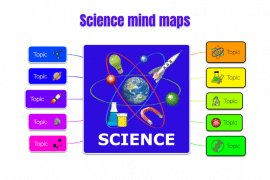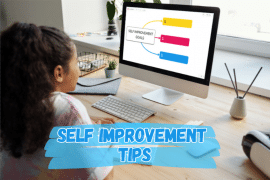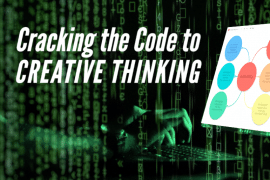
If you want to gain a real-life superpower, becoming a speed reader is one of the best ways to do it. By increasing your reading speed, you complete learning tasks faster, know more, and live a life more enriched by what you’ve read.
Learning these hacks won’t be the easiest thing you’ve ever done. But, it will be easier than learning to read in the first place.
10 Reading and Retention Hacks
Here are 10 ten lessons to help you read faster and digest the information more quickly.
1. Simple Scanning
This is the skill you most likely learned in school. Instead of reading each word in the text, you run your eyes down the page, taking in only the most critical words and elements.
Unfortunately, you probably learned scanning as a way to make reading take longer, as part of a process that included skimming first, scanning second, and then finally reading each word. Although this can be useful when studying a vital text for an upcoming exam, it’s not necessary when you’re running through a book and just need the basics. In addition to it, you can always reach out to high authority proofreading tools, like Grammarly or Essaywriter in case you make additional notes within your preparing program that will be a great supplement to the scanning method.
Many words in a paragraph are connective tissue to make the sentence sound sweeter, but they don’t impart the bones of what it’s trying to communicate. Take the following section from Stephen R. Covey’s “The Seven Habits of Highly Effective People”:
Thomas Kuhn introduced the term paradigm shift in his highly influential landmark book “The Structure of Scientific Revolutions.” Kuhn shows how almost every significant breakthrough in the field of scientific endeavor is first a break with tradition, with old ways of thinking, with old paradigms.
It’s an artful paragraph. But if we cut out the connective tissue and the extra adverbs and adjectives, we’d end up with this:
Paradigm shift introduced by Thomas Kuhn in the book “Structure Scientific Revolutions” shows breakthrough scientific break tradition.
That’s 15 words compared to the original 47 and imparts the same information. It takes time to learn this skill and make it automatic, but you can end up reading three times faster. And with fewer words to take in, you’ll retain more of what you read, even though it sounds like something a caveman wrote.
2. Know Why
This hack is less structured than the one above but still useful. It helps you retain the essential information and triage the words on the page so you read only what you must.
Before you sit down for a reading session, ask yourself why you’re reading this particular book. Are you doing initial research for a report at school or a brief at work? Did a friend recommend it and you want to learn just enough to talk about it with them later that week?
Whatever your reason, define it clearly in your mind. For some people, it helps to write this reason down or even briefly meditate on the topic before getting started.
Once you start reading, you’ll find your mind is primed to catch the information you’re seeking. Related words will stand out on the page more visible than unrelated details. You’ll be able to skip sections that have nothing to do with your goals. You will retain more because you’re focusing on that part of the book and not cluttering your memory with details that have nothing to do with why you’re reading.
Another benefit of knowing why is to know when you’re finished. It’s not cheating for busy adults with rich lives to stop reading a book. You can read until the book has fulfilled its purpose and then go on to something else.
3. The First and Last Rule
We also learn in school a specific method for writing a paragraph: You open with a sentence that tells the reader what to expect. Your ending encapsulates the paragraph’s main point. The middle contains details that support or embellish the information in the first and last sentences.
This means you can generally skip that stuff in the middle, especially if you’re reading for the main ideas or are already familiar with the topic. Simply read the first and last sentences, then move on to the next paragraph. If you’re not confident you fully understand the previous sentence of a given section, then go into the middle sentences so you can get the details you need.
Paragraphs are not sandwiches. In a sandwich, the good stuff is in the middle, with the bread just serving as a necessary container to keep your fingers clean. With paragraphs, it’s the outside layers that are the most important, and you can skip the stuffing without losing much value.
4. Read the Phrase, Not the Word
This technique is sometimes called “soft eyes.” It takes advantage of your physiology to increase reading speed.
Your eye span is 1.5 inches wide. A mass-market paperback fits about 10 words on 3 ¾ inches of text. That means any word is less than five times your working eye span. You can take in all the words within that span in a single chuck and comprehend what they mean together.
To make this technique work, aim your eyes at every fifth word or so, but don’t focus on that word alone. Instead, make that the center of your taking in that word and those around it. Your mind will take a snapshot of that image, and with practice, you will process the sequence of word snapshots as a cohesive whole, understanding and retaining their content.
5. Dialogue for Days
Speed-reading fiction is often less advisable than speed-reading nonfiction since the details of the characters and prose are part of what makes it fun. Sometimes, though, you’re charging through a book you feel is so-so but need to finish for one reason or another.
In that case, reading the dialogue in any scenes where people are talking is a vital technique. The overwhelming majority of non-dialogue words when people speak consist of dialogue tags like “he said,” “she interjected,” or small bits of unnecessary detail about the speakers’ physical tics while they talk. You can get vital information from the scene just from what the characters say.
This trick works for nonfiction, but you can often go one step further. With a few exceptions — notably, memoirs and biographies — you’ll find dialogue in nonfiction is an example illustrating a point the book is about to make. If you understand the point without the example, you can skip the conversation altogether.
6. Lose Your Voice
When you learned to read, you learned by reading out loud. You vocally sounded out the words as you read them, linking the sound they represented with the sound they made. After a while, you blended the individual letter sounds together into words and became capable of sight-reading: perceiving familiar words as a single idea rather than a collection of sounds.
Many people still read at that level today, sounding out each word in their mind as they read through a process called subvocalization. But there’s another level to reading we’re rarely taught.
You don’t read the word “card” as C-A-R-D anymore. You recognize the letters’ shapes together and know it’s a word with a specific pronunciation and meaning. You only have to sound out new, unfamiliar words and names you haven’t heard before.
The same thing is possible with phrases, sentences, and even paragraphs. Instead of sounding out the sentence word by word, you can learn to recognize groups of word shapes as a phrase with a specific composition of words and a set of information to impart.
Start learning this skill by silencing that inner voice. It was useful as you learned to read individual words but interferes with the next reading ability.
7. Using a Pointer
Use the tip of a pencil, a pointing stick, or the edge of a bookmark to follow along with the text as you read. Although humans are the only species that reads, we still spend far more time in our shared history scanning the area for food and predators. Our eyes want to wander and take in extra information, which is why you sometimes have to reread a paragraph even though your eyes made progress down the page.
Even if it’s just your finger, a pointer helps you keep your eyes focused on the words and your task. You’ll retain not only the physical focus of your eyes but also the mental focus required to retain what you’ve read.
Using a bookmark or other straight edge focuses your eyes on a whole line of text instead of a single word. You can use this as a sort of training wheel to read in blocks of words rather than the words one by one.
8. Read in Shorter Bursts
Most of us have experienced reading an exciting novel well past our bedtimes. Our eyes blur, we lose focus, and we don’t remember what we read on the previous page. That’s fatigue robbing us of our reading speed and retention.
Less extreme versions of that, where we’re not falling asleep but we read more slowly and retain less than we should happen faster than we think. The next time you need to read something quickly, try reading in chunks of just 10 to 20 minutes.
You can do multiple chunks in a sitting, but take a few minutes to stretch, walk around, or work on something different in between. You’ll find you get through more pages in your reading time than if you spent that time in one long reading binge. As you get better, you may even discover you get through more than you would have by reading the entire time without breaks.
If you want to improve your attention and focus span, the Pomodoro technique is a robust strategy for doing just that. It helps you build your attention span the same way a physical workout builds muscles: by gradually increasing loads to boost your capability.
9. Preframe
Earlier, we pooh-poohed the middle school technique of skimming, then scanning, then reading. We stand by that, but it doesn’t mean there isn’t some value in a modified version of that approach.
If you have a reasonable understanding of the structure of what you’re about to read, you can digest it more quickly and easily. You’ll know which sections you can give only scant attention to — or skip entirely — and which are likely to contain the information you most need to get out of it. If the book is written in sections with a similar structure, you can learn the best way to mine each section for what it has to tell you.
Preframing often works well when combined with understanding why you’re reading. Sometimes you can’t even know why you’re reading until you have a top-level grasp of the book’s contents and organization. Other times, your preframing happens fully informed by what you’re trying to gain. Either way, it helps you to read faster, focus more on the most relevant sections, and better retain what you find.
10. Notes and Highlighting
Although taking notes and highlighting essential passages takes extra time, it can help your retention more than almost anything else you try. Often, the physical act of making the note fixes the information in your memory strongly enough you never have to review the notes you took.
We mention this last because it synergizes well with the other techniques on this list. For example, if you scan the text with your reading goal in mind, using your highlighter as a pointer, you can more than make up for the time you spend highlighting the essential parts. Experiment with different combinations of these strategies to find the ones that work best for you.
Mind mapping software is a great tool that helps you take notes as mind maps easily and fast. It’s also a creative and fun way to do it, helping you even more to remember the notes you’re taking.
You can also use mind mapping to create quick book summaries. (read more about how to make a book summary using mind maps)
Final Thought: Worth the Effort?
You may have heard of DVORAK keyboards. Your standard keyboard (called a QWERTY, for the five letters on the left side of the top row) was designed for mechanical typewriters and intentionally slowed down typing so the user wouldn’t jam the mechanism by going too fast. DVORAK keyboards are arranged to maximize typing speed, and they work. However, anecdotal evidence suggests they rarely speed up typing enough to make up for the time spent relearning how to type.
It can be like this with learning speed-reading and retention techniques. Suppose you only read for pleasure, especially if you enjoy the experience of reading and spending meaningful time with elegant prose and well-drawn characters. In that case, it’s probably not worth the time and energy it would take to master any of the techniques above.
However, if you read for work or your hobbies, then these strategies can be valuable investments of your attention and these are great ways to capture ideas.
Author:
Jamie Wilson is an avid reader who reads more than 100 books annually.






